Following our analysis of Rijeka under Simon Rožman last week, we’re continuing our project of bringing you the tactics of the best teams from 1. HNL. With that in mind, this tactical analysis will focus on Ivica Kulesevic and his philosophy at NK Osijek.
Initial data analysis
Before we delve deeper into Kulešević’s tactics at Osijek, first we will consult the data and statistics to determine the team’s main trends, key players, and general tactics. When talking about certain styles of play, we have divided the teams within 1. HNL into those that practice a direct style and positional style, depending on the passes they prefer.
The teams who tally a large number of lateral passes are therefore categorised as more positional while teams who focus on long balls are more direct in their approach. We can immediately see that Osijek, along with other big teams like Dinamo, Rijeka, and Hajduk, are one of the more positional teams in the league.
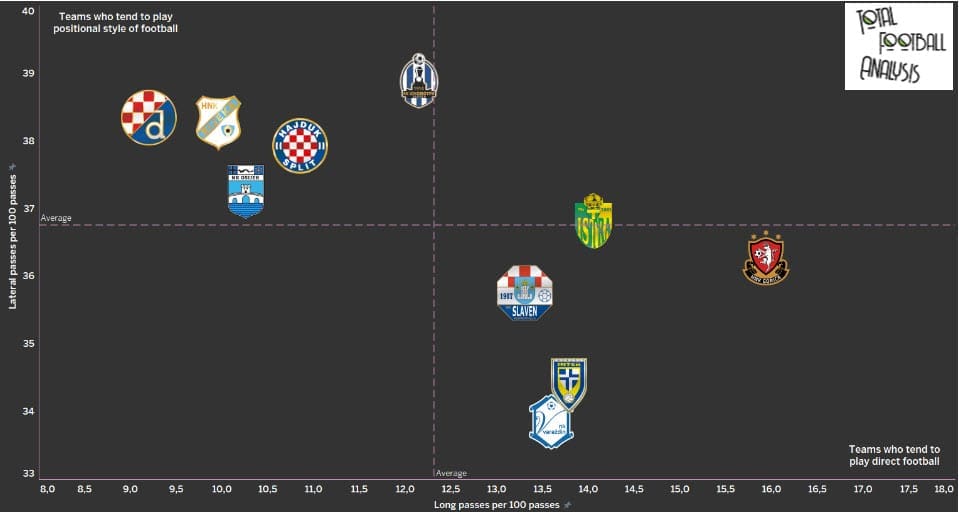
But it is also true that they do deploy more long balls than the current two best teams in the league and somewhat fewer than Hajduk Split. Still, this is enough to tell us they are indeed a positional team that likes to be in control of the possession and dictate the tempo of the games.
However, we will also see that this largely depends on the opponent and the setup they are using, as it will have a major effect on their tactics. But more on that later on in this tactical analysis.
Next, we will explore their defensive style of play. By measuring the distance from which teams allow their opponents to shoot and their PPDA values (passes allowed per defensive action), we can differentiate between four major defensive styles, all of which can be seen down below.
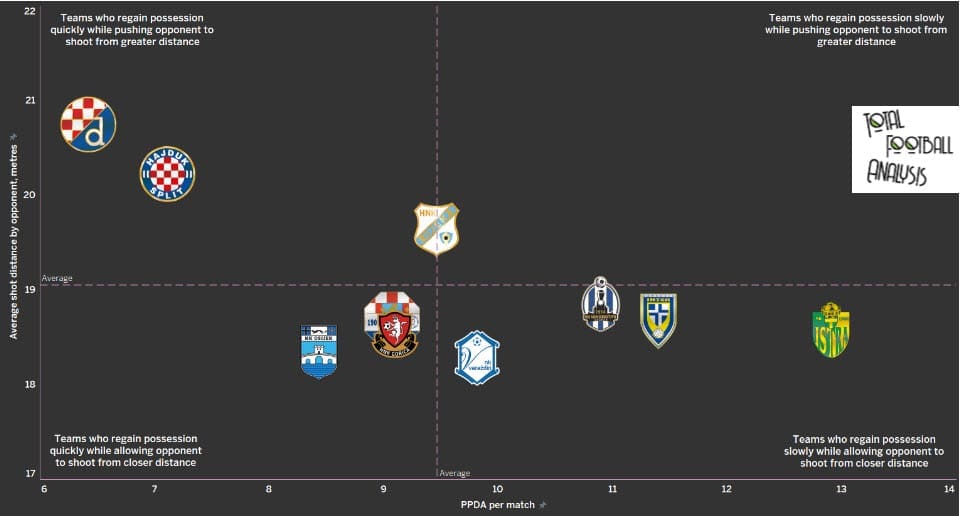
And while the bigger teams keep their opposition at bay and also tally low PPDA values, Osijek are the third-most aggressive pressers in the league but they still allow their opposition chances nearer to their goal.
We will explore their defensive tactics more a bit later on but in general, however, 12% of their goals conceded in 2019/20 have come from long shots, 12% from counter-attacks, 4% of direct free-kicks and penalties and 24% after set-pieces. Moreover, 14/25 were conceded in the first half of the games and 10 in the last 15 minutes of the first half, which could indicate a drop in concentration as they approach half-time. But given that those are mostly the same time-spans during which they create the best chances, we can conclude that they tend to open up more as the end of the half draws closer.
But it is also important to state they only allowed 8.98 shots per 90 minutes in 2019/20, which is the second-best value in the league, only behind Dinamo Zagreb’s 7.63. Now that we have established their general attacking and defensive styles, we can start highlighting their key figures in all phases of play.
First of all, we’ll take a look at their age profile which will tell us more about the players Kulešević likes to use the most and of course, their age group. With an average age of 25.21, Osijek don’t exactly have the youngest of teams but while there are three players at the age of 30 in the squad, none of them has a significant role in the squad.
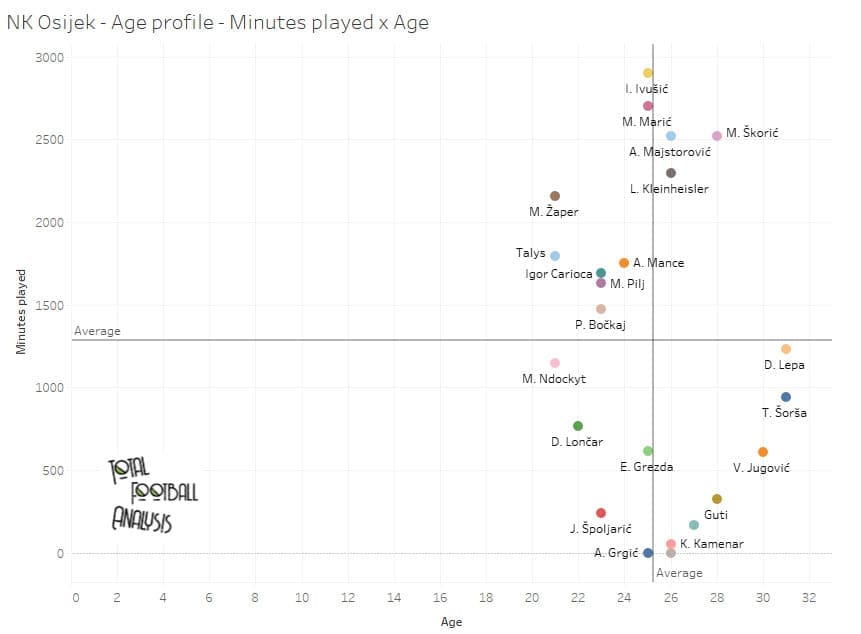
The oldest player to tally above-average minutes in 2019/20 is the 28-year-old Mile Škorić. Indeed, he could be important for Croatia at the upcoming European Championships. Those that think Croatia could have a great chance in the upcoming competition, should consider using the best Tippa EM that can be found ahead of the tournament.
The most important players, however, are mostly around or behind the average line in the graph that you can see above.
Ivica Ivušić and Mirko Marić are two great examples of that, while we also have Ante Majstorović who joined from Dinamo Zagreb and László Kleinheisler with important roles to play in the team’s tactics. Of course, there are players like Grezda, who returned from Rangers in the winter and while he is a still a big part of the squad, he couldn’t tally too many games since his return.
They also seem to have quite a few young, up and coming players like Merveil Ndockyt, the La Liga loanee who also played for Barcelona’s youth team or Mihael Žaper and Talys.
Next, we will take a look at the best defenders in the squad by measuring their defensive duels won in % and defensive duels per 90 minutes. It has to be said that Osijek as a team are last in the league when it comes to successful defensive duels with 59.66%, way below the league average of 66.66% and the first-placed Varaždin with 75.64%.
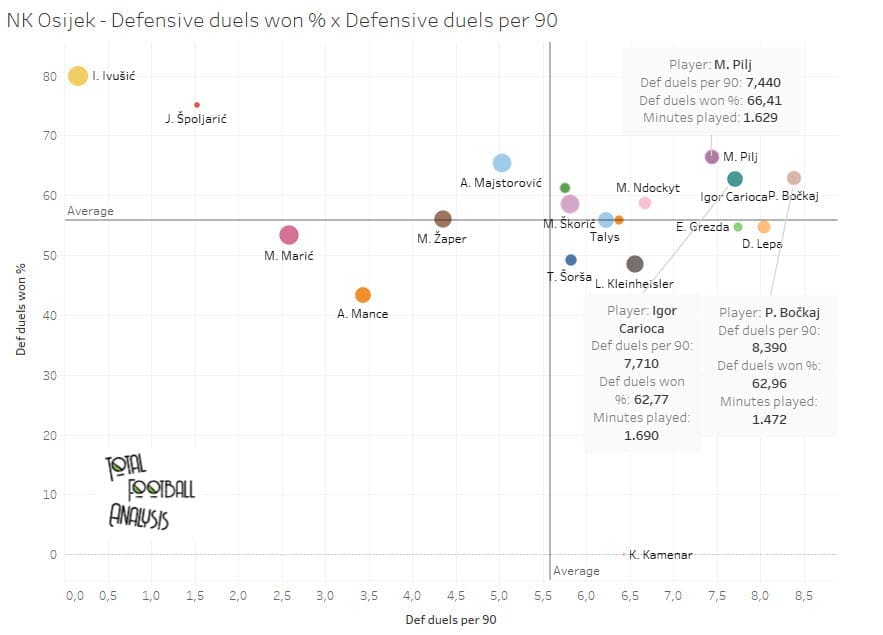
Petar Bočkaj is one of the more impressive players on this list. He averages the team-high 8.39 defensive duels per 90 and also wins 62.96% of all of them. Igor Carioca (Igor Silva) follows him closely with 7.71 and 62.77% while Marin Pilj averages 7.44 and 66.41% respectively. With both Pilj and Bočkaj being attacking players and Silva also being an aggressive full-back, we can immediately see Osijek’s high-pressing tendencies here.
This is then confirmed by the presence of both Eros Grezda and Dmytro Lepa on the graph. But what about Osijek’s best-attacking players? We’ll start things by measuring the basics – goal contribution – goals and assists per 90 – and expected goal contribution – expected goals and expected assists per 90.
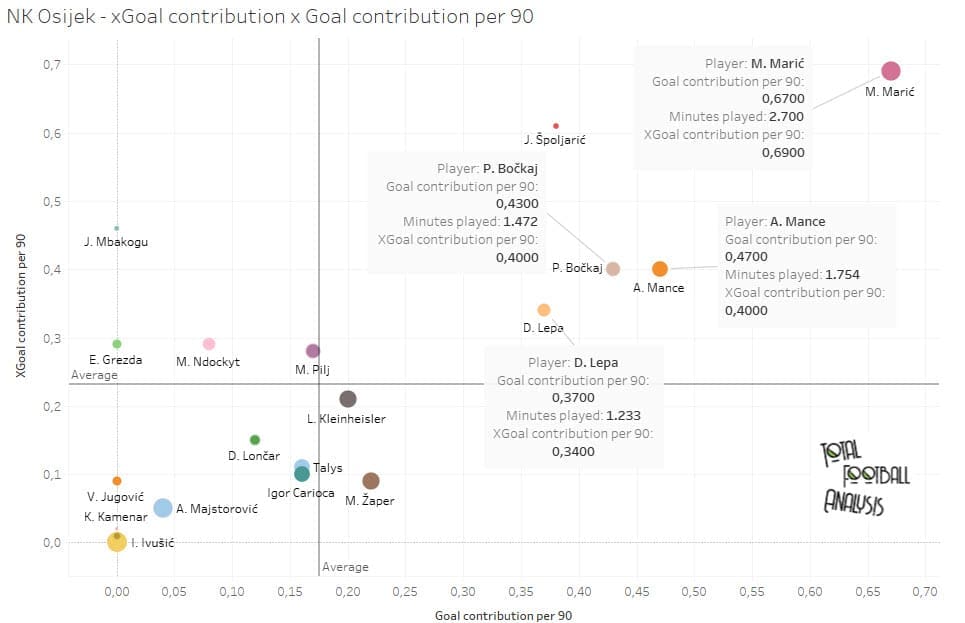
Marić is the clear stand-out player on this graph with his 0.67 goal contributions per game. It has to be said, however, that he is still slightly underperforming his xGoal contribution, which stands at 0.69.
Other impressive names include Antonio Mance (0.47 and 0.40), Bočkaj (0.43 and 0.40) and Lepa (0.37 and 0.34), all three slightly overperforming their expected values. Now we move to creativity within the squad by measuring their passes to danger area per 90 minutes (passes to final third and passes to penalty area per 90) and their key passes per 90 minutes.
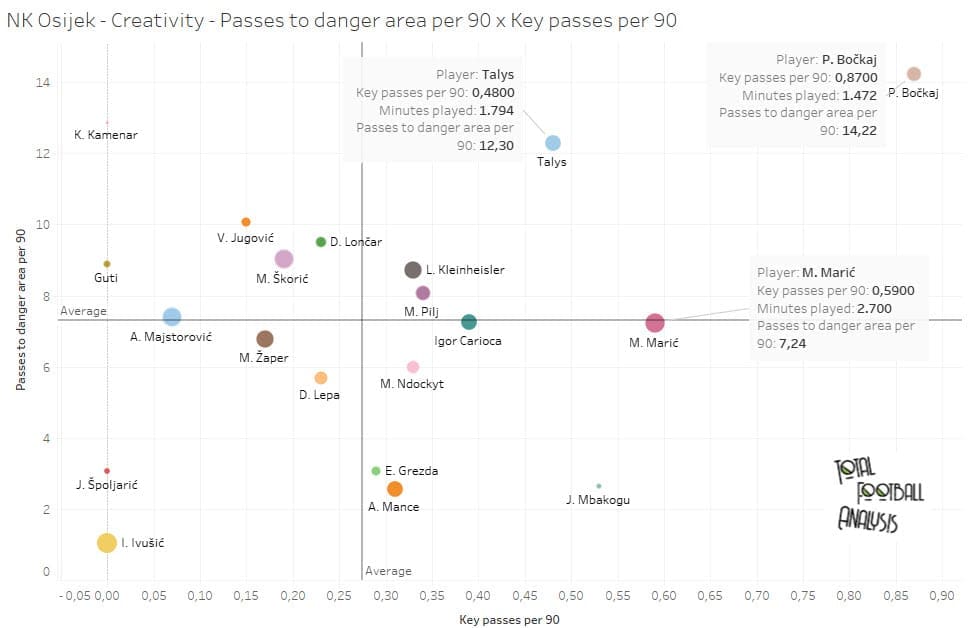
We have highlighted three names on this graph. The obvious pick is of course Bočkaj with 0.87 key passes per 90 minutes – he is among the best players in the league in this department – and 14.22 passes into the danger area per 90 minutes.
Bočkaj is then followed by the full-back Talys with 0.48 and 12.30 respectively. We also have to mention Marić who doesn’t tally as many passes into the danger area due to his positioning on the pitch but is way above-average in key passes with 0.59 per 90 minute, the second-best value in the squad.
Other players worthy of mention here are Kleinheisler, Pilj, and Silva as all three tallied above-average values in key passes and the latter slightly below-average in passes into the danger area.
Our final graph will deal with ball progression by measuring the players’ total passes per 90 minutes and their progressive actions per 90 minutes (progressive runs and progressive passes per 90 minutes). This will show us the players who have a big role in the build-up as well as in bringing the ball forward.
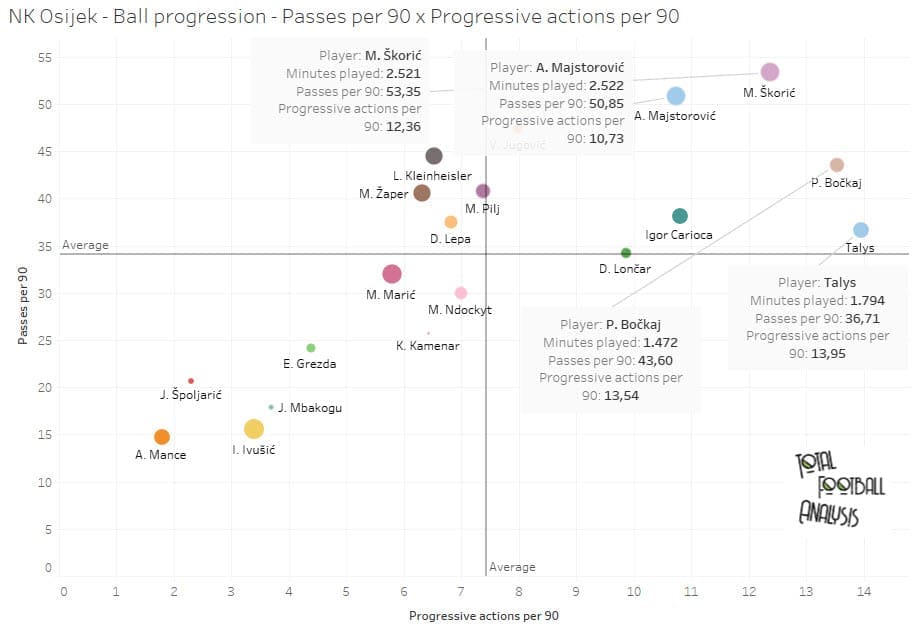
Talys is the best progressor in the squad with 13.95 progressive actions and he also tallies above-average passes per 90 minutes with 36.71. Bočkaj is once again one of the more impressive names on the list but we also have the appearance of Škorić and Majstorović, the centre-back pairing, both of whom are extremely involved and also progress the ball well.
This tells us two things about the team: the presence of the defenders on the graph shows us they tend to build from the back and play positional football while the full-backs and wingers also making an appearance in progression means they like to advance through the wide areas.
With the data analysis out of the way, we can start dissecting Kulešević’s tactics at Osijek.
Build-up tactics
Throughout the season and under Kulešević, we have seen Osijek in probably one too many systems. And while this is a problem that should be addressed sooner rather than later, there have been a couple of structures the coach seems to prefer.
In 2019/20, Osijek have used a 5-4-1 formation in 18% of their games and then a 4-4-2 and a 3-4-2-1 in 11% – these three are their top three setups throughout the campaign. But it feels like the structure very much depends on the opposition and generally, Osijek are a team that seems torn between direct and positional styles of play.
Against aggressive and dominant teams like Dinamo Zagreb or Hajduk Split, they adopt a more passive approach as a result of the other team controlling possession. In both of those games, we’ve seen them focus on the direct approach with long balls over the top and then ensuring the second and loose balls are won with numbers.
Let’s observe such a scenario against the Blues in the example below. The ball has been sent long from the goalkeeper and into the opposition’s half. Osijek collapse in numbers and ensure they win the aerial duels to advance the play.
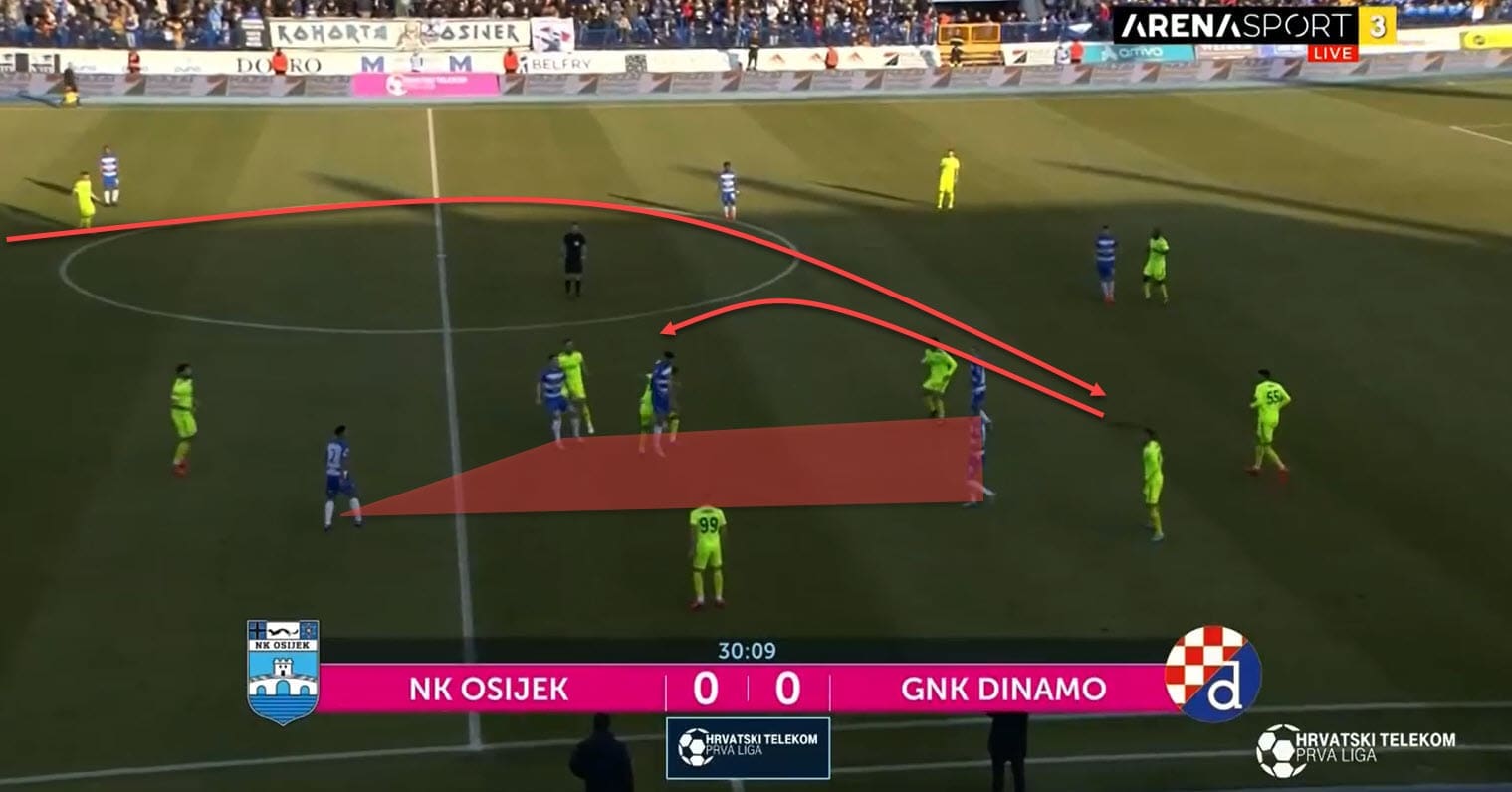
And this approach has been evident on multiple occasions when Osijek don’t want to contest possession against bigger and more dangerous teams in the league. But that seems to be a big problem because they have the necessary tools to play great positional football. Ivušić doesn’t often participate in the build-up and usually, when the ball is recycled back to the goalie, he will send it long despite there being channels open for a clean and steady progression.
This is an issue the backline faces at times too – despite having good ball-playing centre-backs, they are prone to panicking and will try and get rid of the ball when pressed. Notice below, once again against Dinamo, how despite a forward dropping and opening a channel, Osijek opt for a long-ball approach instead and lose it shortly after.
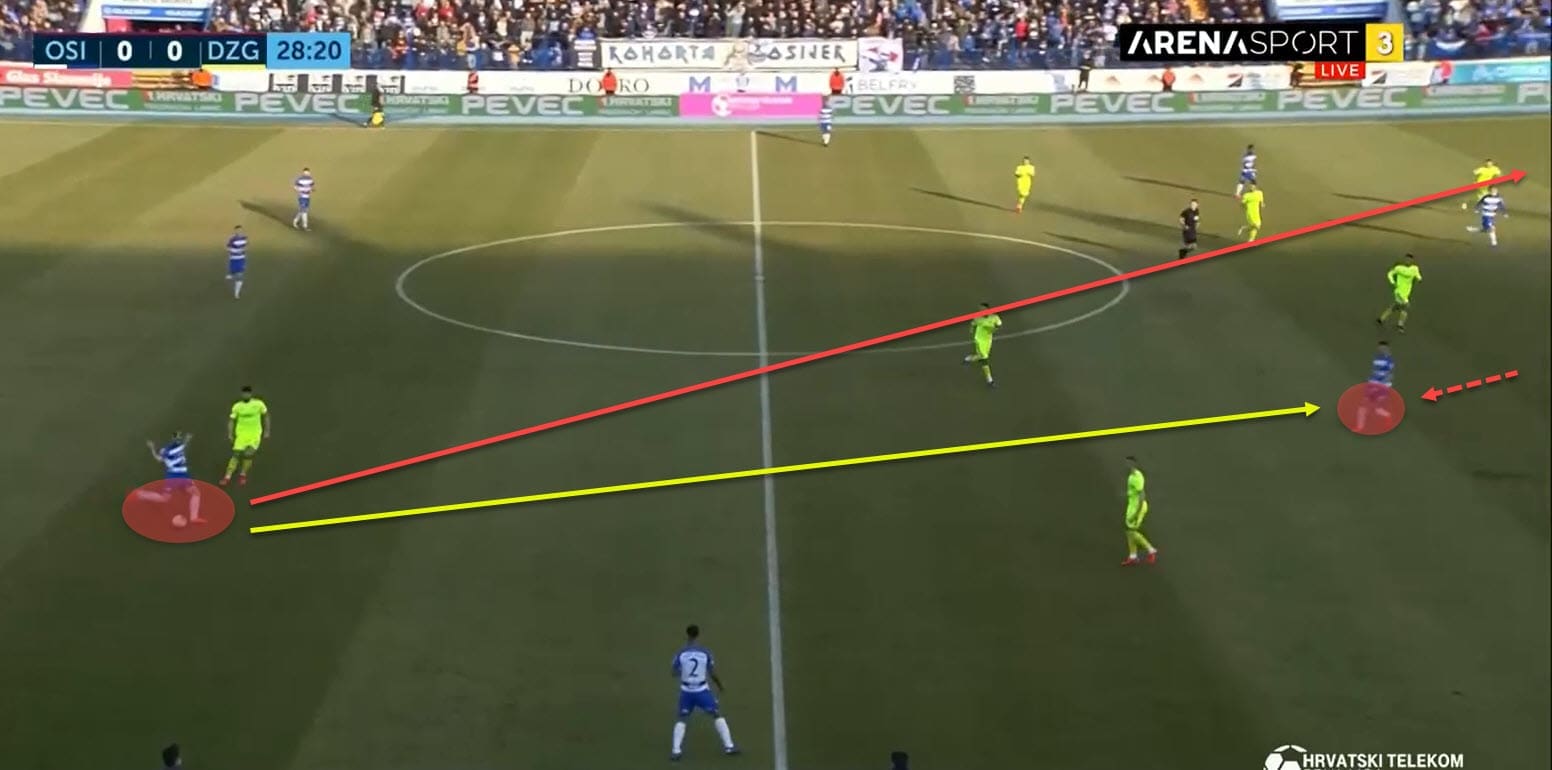
The red line represents the option they opted for and the yellow one the alternative approach. The forward is asking for the ball into his feet and the defender had the time and space to deploy the pass had he immediately gone for it.
And this is not an isolated case, either. We can see another example below as Ivušić decides to go long and Osijek seem to rely on winning the second or loose balls to advance the play. Considering they had a dropping pivot and a 4 v 2 advantage in the first phase of build-up, they had the tools to safely progress and retain the ball at the same time.
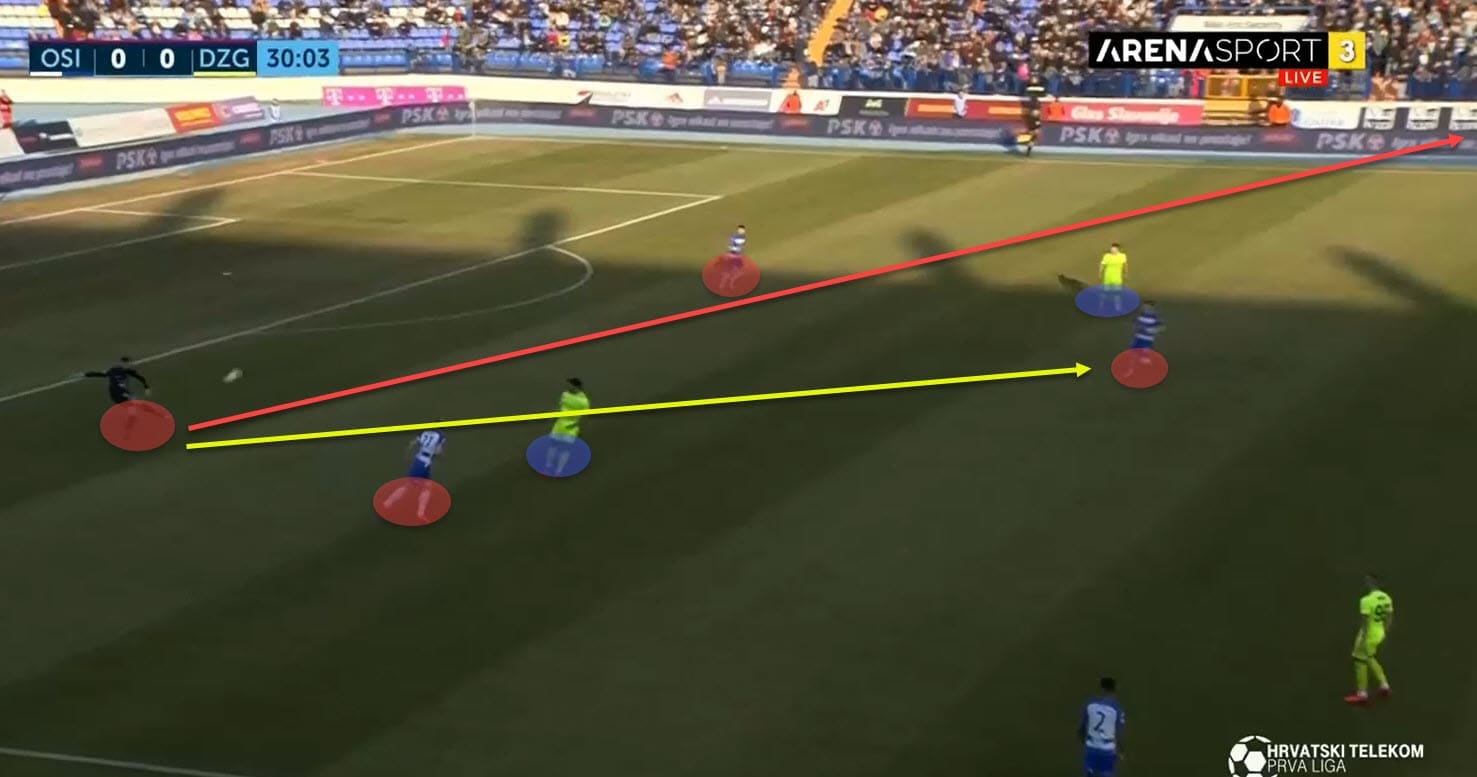
But it’s not like they don’t know how to play that way. Osijek under Kulešević are, after all, one of the more positional teams in 1. HNL even though they are the least inclined of the top teams to go down that route. And intriguingly enough, some of the best examples of that arrived against Rijeka in the Croatian Cup and in a game they lost 3-2 after taking a 2-0 lead.
It is there that we’ve seen a couple of excellent build-up tactics that were founded on establishing numerical superiorities in all phases of play. We can see an example below as Osijek deploy an attacking formation with three in the back, pushing the full-backs up and still creating a favourable 3 v 2 situation in the first phase of play.
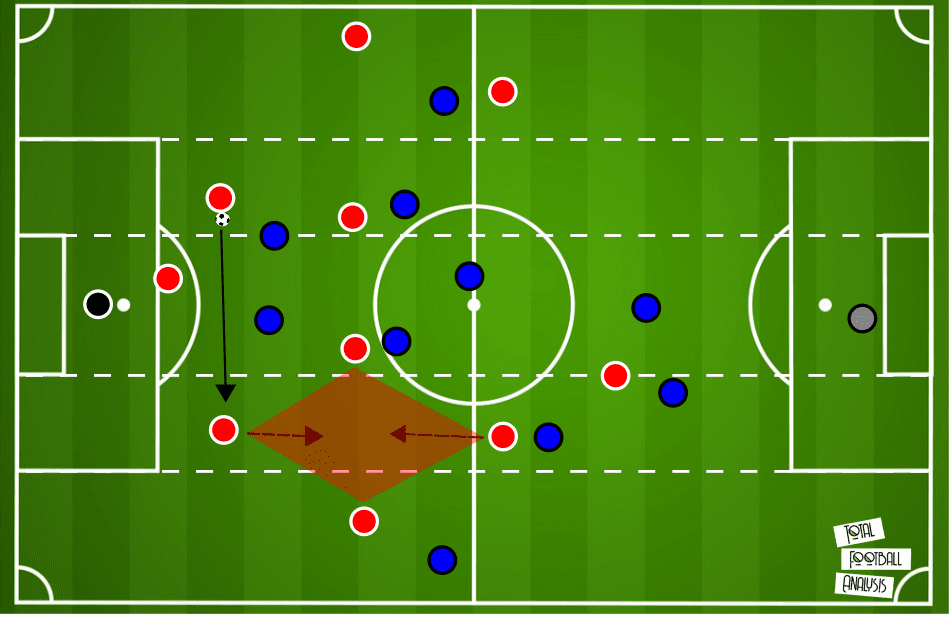
In the above scenario, Osijek can easily bypass the opposition’s two-man pressing squad and enable one of the defenders to push forward into open space. That way, he creates numerical superiority in the wide channels and can progress the ball towards a dropping wide forward.
The centre-back, the forward, the midfielder, and the full-back can then combine to outmanoeuvre the opposition’s pressing squad or simply force them to commit more players into the area, ultimately opening up other parts of the pitch, which they do in the end.
Here’s an in-game example of a very similar situation where the centre-back ventures forward due to space opening up as a result of numerical superiority in the first phase.
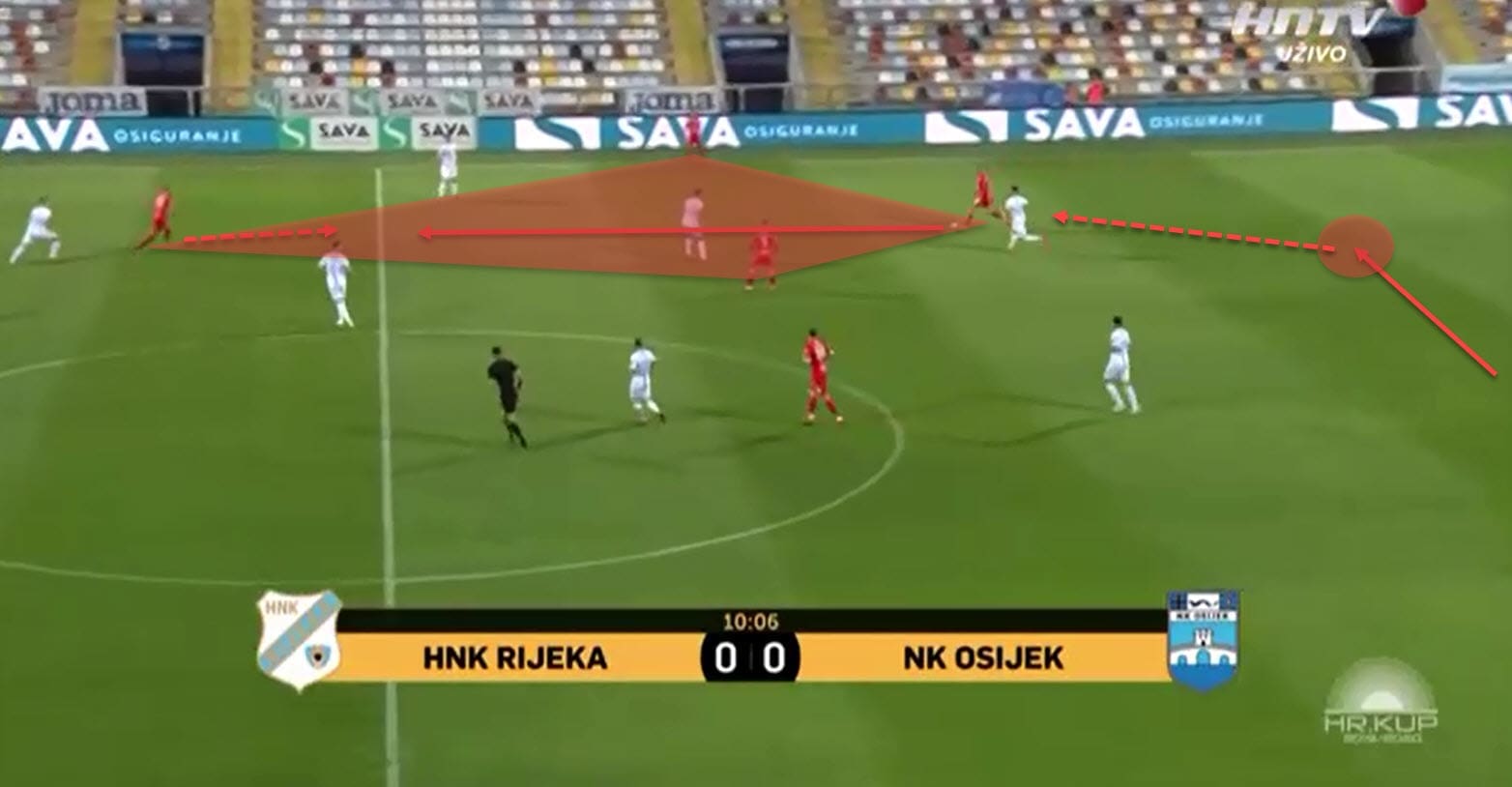
Even though they may not utilise it exclusively at all times, some of their best actions come from precisely that kind of tactics. We have an almost identical example of that against Hajduk in the following image. A 3 v 2 in the backline allows the ball to easily be recycled and one of the defenders can charge into open space, carrying the ball forward.
The forward drops to drag his marker and offer an additional passing channel and Osijek can combine out wide, creating overloads on the opposition’s wide defenders and ejecting their players into space on the flank.
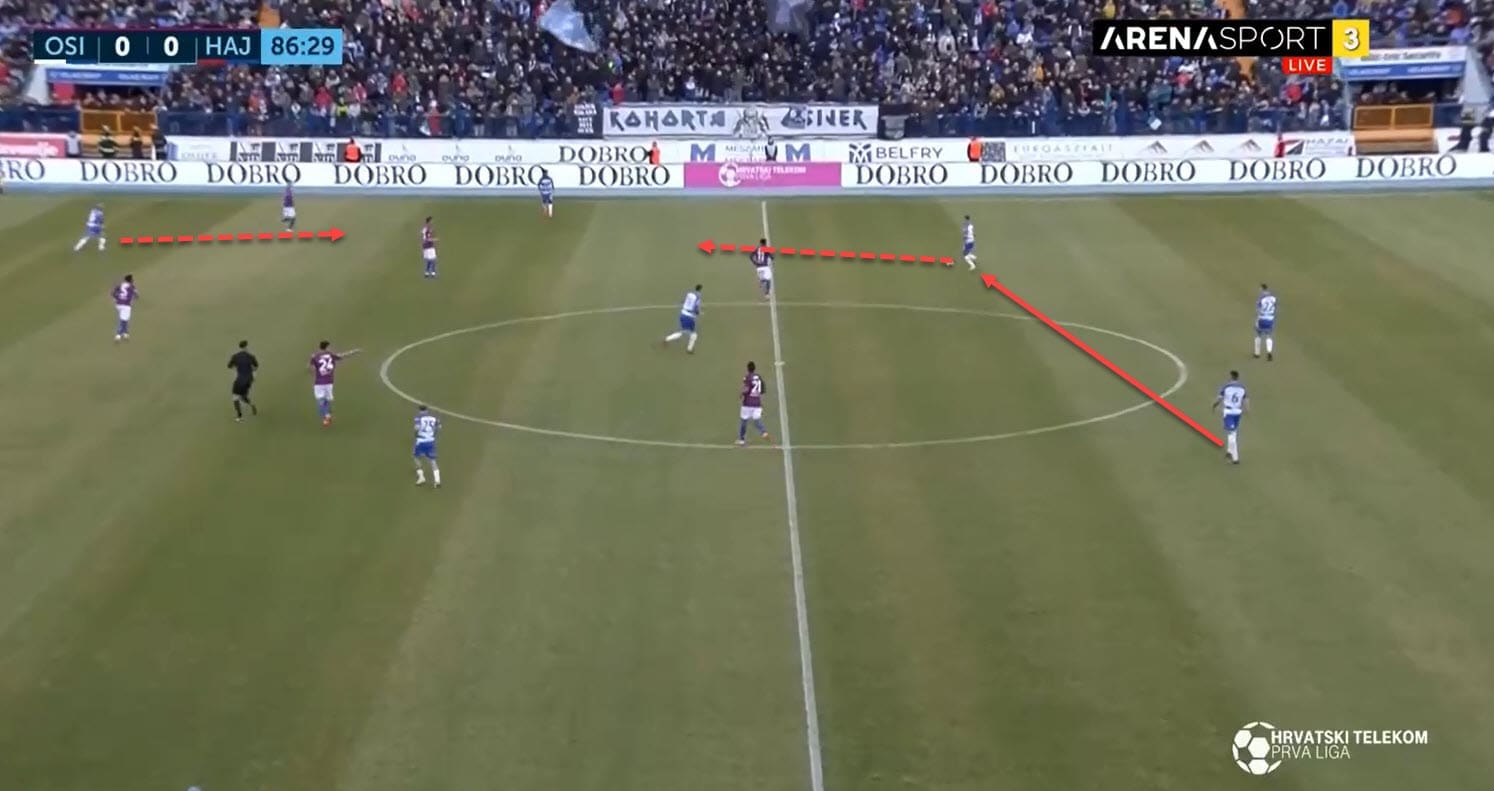
Now, let’s observe another way of progressing the ball directly from the backline.
Here, Osijek again have a numerical superiority in the backline, this time forming the back three with the full-backs as well, similarly to the previous image and again vs Hajduk. The Split team are pressing with two players and are trying to cut the passing lanes but with the movement of the midfielder, who drags his marker away, and the wide players occupying their counterparts, a forward can drop into the half-space and receive the ball directly from the backline.
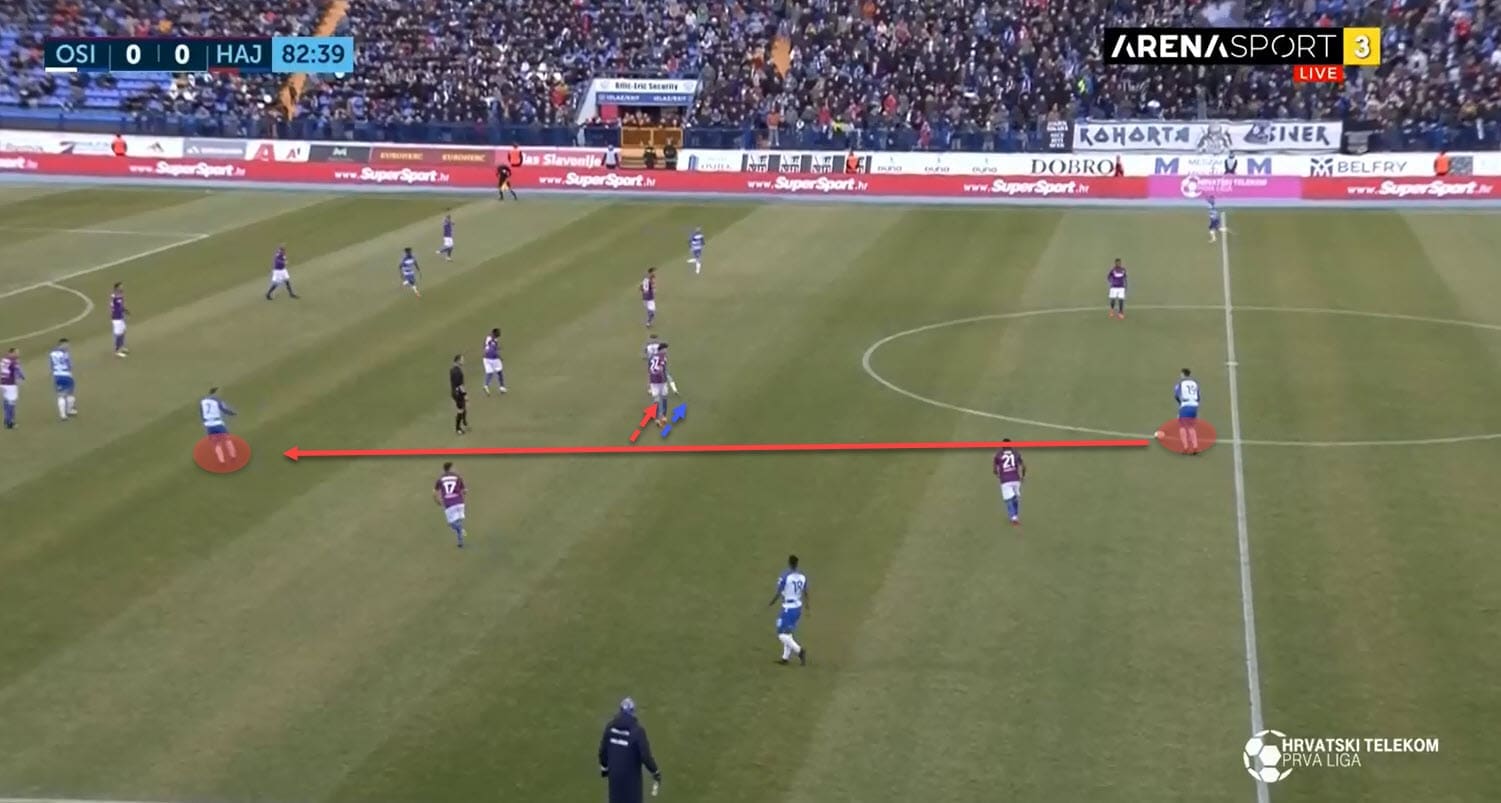
The last variation we’ve seen them do is in a formation with four in the back. In possession, they spread the centre-backs and push the full-backs high. Then, one or two midfielders will also drop to support the build-up and help carry the ball forward. We’ve seen such a system against Istra where Osijek were given control of the possession.
That worked well against a two-man press and a narrow block since the full-backs are then given enough freedom to burst forward and combine with the wingers in the half-space.
So it’s a real shame they don’t utilise this kind of structure more often as it seems like it would suit them. Of course, since Boško Šutalo’s departure to Atalanta, Osijek lost a great ball-playing centre-back who would be perfect for that role but they do seem to have enough quality to sustain that kind of a system.
Final third tactics
Watching Osijek in action in the final third, it does seem like they have quality options going forward and at times, they rely on that individual skill a bit too much. Still, with that being said, there are some tactics worth pointing out in attack.
Across 1. HNL, Osijek are the team who utilise their central channels the least, 34%, with 34% of the attacks focusing on the left and 32% on the right flank respectively. This goes hand in hand with the fact that they thrive when isolating their wide players with their markers and also when they utilise the half-space effectively to eject the bursting forwards into space.
We’ve already seen them exploit direct channels, opening passing lanes from the backline to the forward line by manipulating the movement of the opposition. This sounds more complicated than it is and the key is to lay off the ball into open space. We can see an example of that in the graph below.
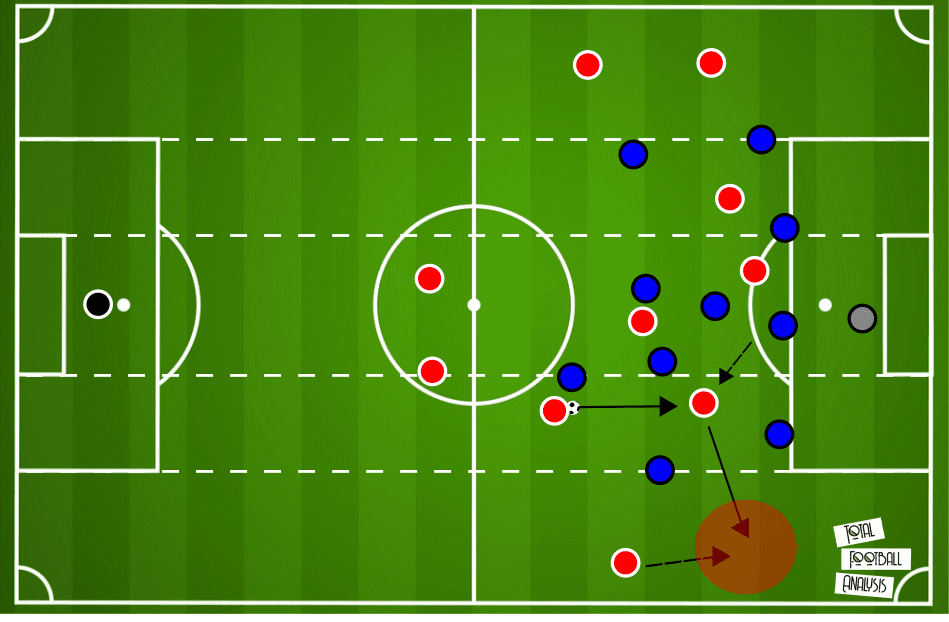
Osijek are facing a compact block and have possession in the opposition’s half. We can see that their full-backs are positioned higher and are hugging the touchline, spreading the defensive lines as much as possible. At the same time, the wingers will tuck inside and occupy the half-space while the midfielders carry the ball forward and send it towards them.
A simple lay-off can eject the full-back and he is then moving into a position for a cross or just a cut-back ball into the danger area. And we can see an in-game example against Dinamo Zagreb below, which is also from a game where Osijek couldn’t control the possession but would still try to implement the same principles.
Let’s observe it in the following image.
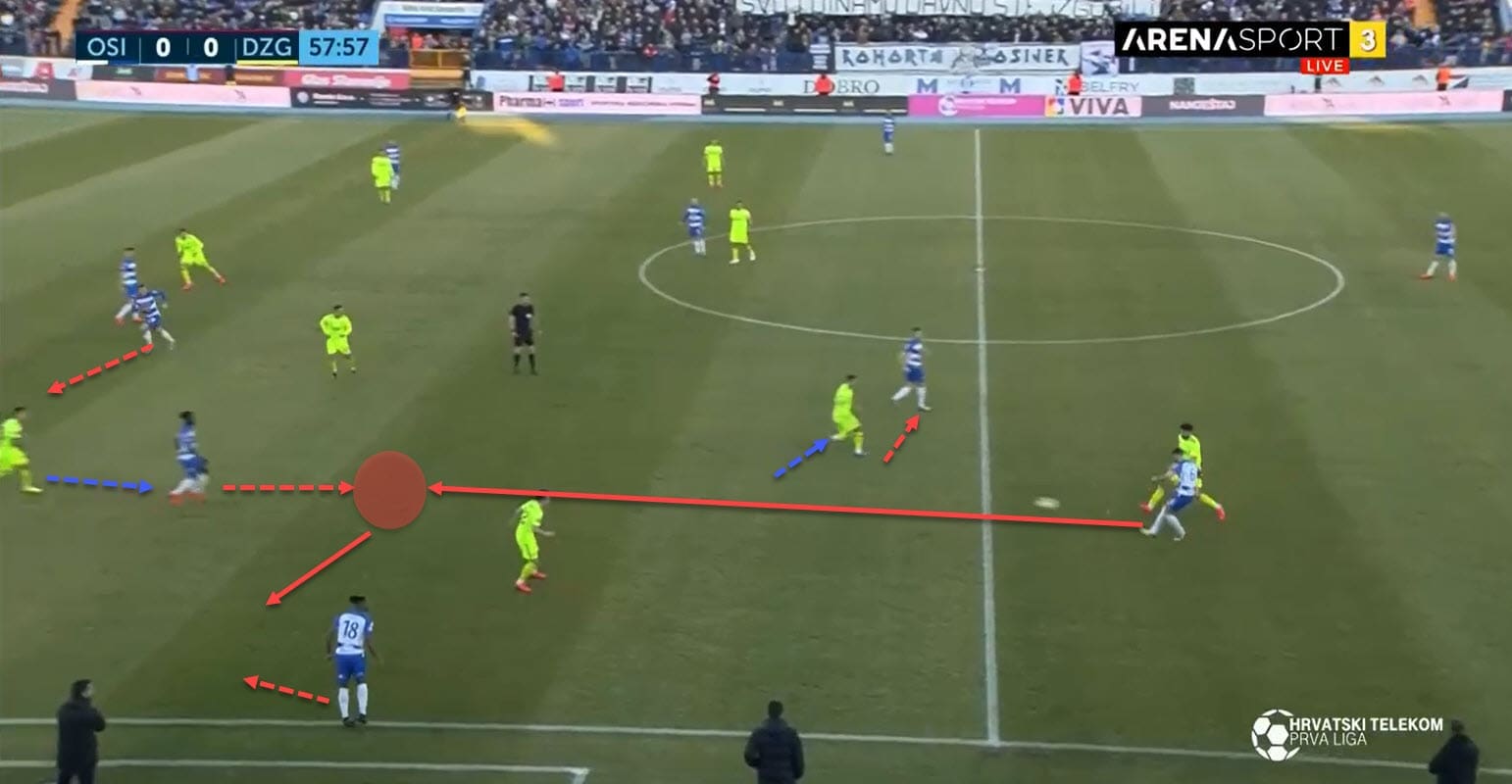
Once again, we have the centre-backs positioned high but still pushing forward with the ball. The full-back hugs the touchline to create width and the winger is dropping into his half-space to receive the ball from the backline.
Also note how the midfielder moves centrally to drag his marker and open the channel towards the forward and the centre-back immediately tries exploiting it. It has to be said that Osijek fail to get the ball to the left-back successfully in this instance but it still shows us the tendency and how they like to open up and exploit passing lanes when attacking.
That last example also shows one of the other forwards immediately darting into the space behind the defender’s back as soon as he is dragged away by the dropping winger. This is also not a coincidence because Osijek are the team who sends out the most through balls in the league with 10.68 per 90 minutes, miles ahead of the 1. HNL’s average of 7.49 and the second-placed 8.68 from Dinamo Zagreb.
That’s exactly why they love to have their wide speedsters isolated with the defenders as they then send piercing through balls into space for those forwards to exploit. Similarly, 21% of all of the goals they’ve scored have come from counter-attacks and 18% from direct free-kicks and penalties and those two categories stand out as their most effective weapons in 2019/20.
Another interesting concept in the attacking phase is crossing. Since they have such an emphasis on the flanks and getting into the wider areas, it doesn’t surprise they deploy the third-most crosses per 90 minutes in the league with 17.38 while the average is 15.37. Let’s observe one wide combination that set them up for a good crossing scenario.
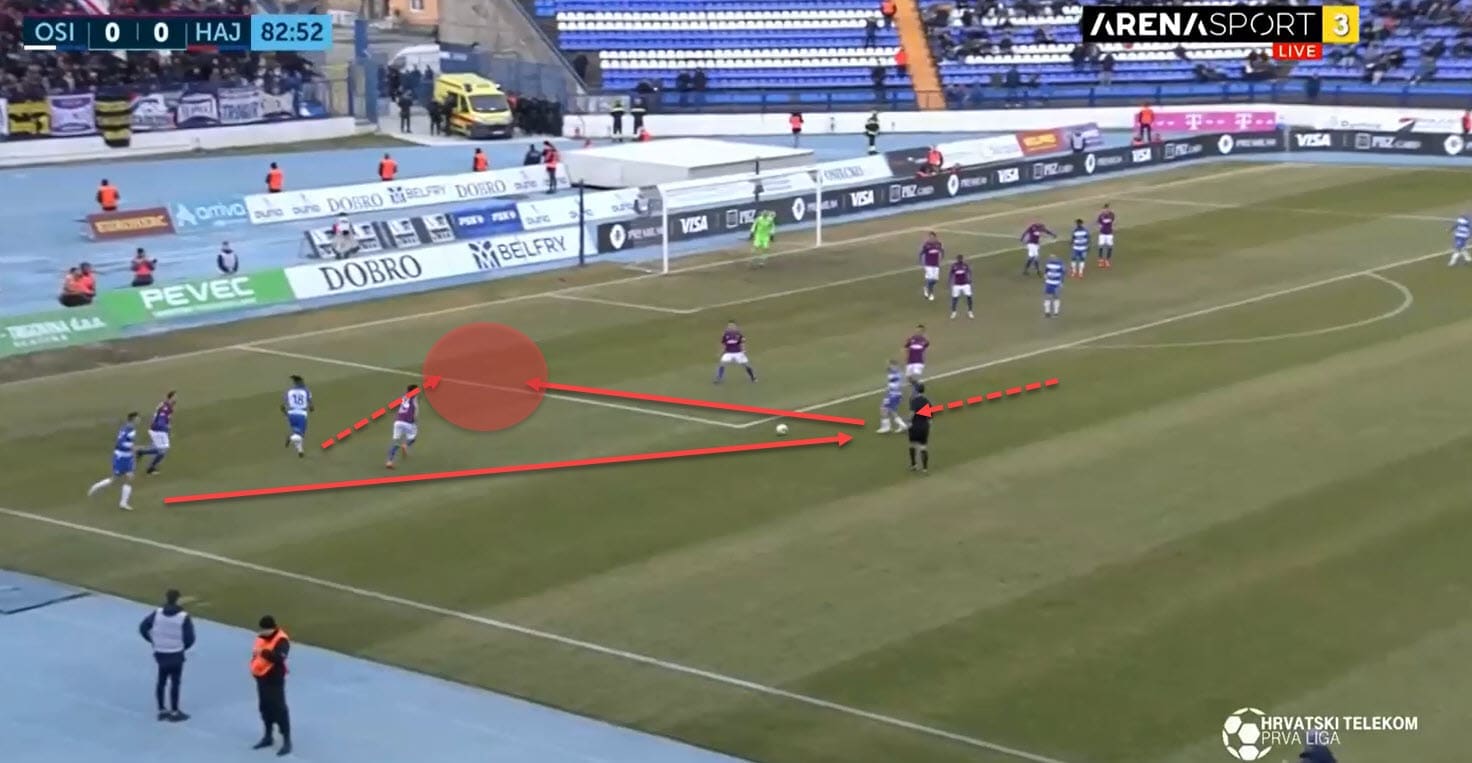
In this instance, Osijek create an overload out wide to eject their player into space on the left and into a crossing position. The midfielder joins them on the wing from the central area and simply lays the ball off behind the opposition defender’s back.
But it’s also interesting to note that Marić, their forward, is the one deploying the initial pass from the touchline. Even though they don’t have a set-in-stone frontline, Marić is a key cog in attack and we can often see him drift wide or drop deeper to connect the thirds and combine with his teammates.
This is also something Mance sometimes does as well, albeit with differing results. In the next example, we can see Mance dropping deeper to drag the marker and Marić then quickly darting into space to meet with the through ball. Unfortunately for Osijek, the pass ends up in Dominik Livaković’s hands.
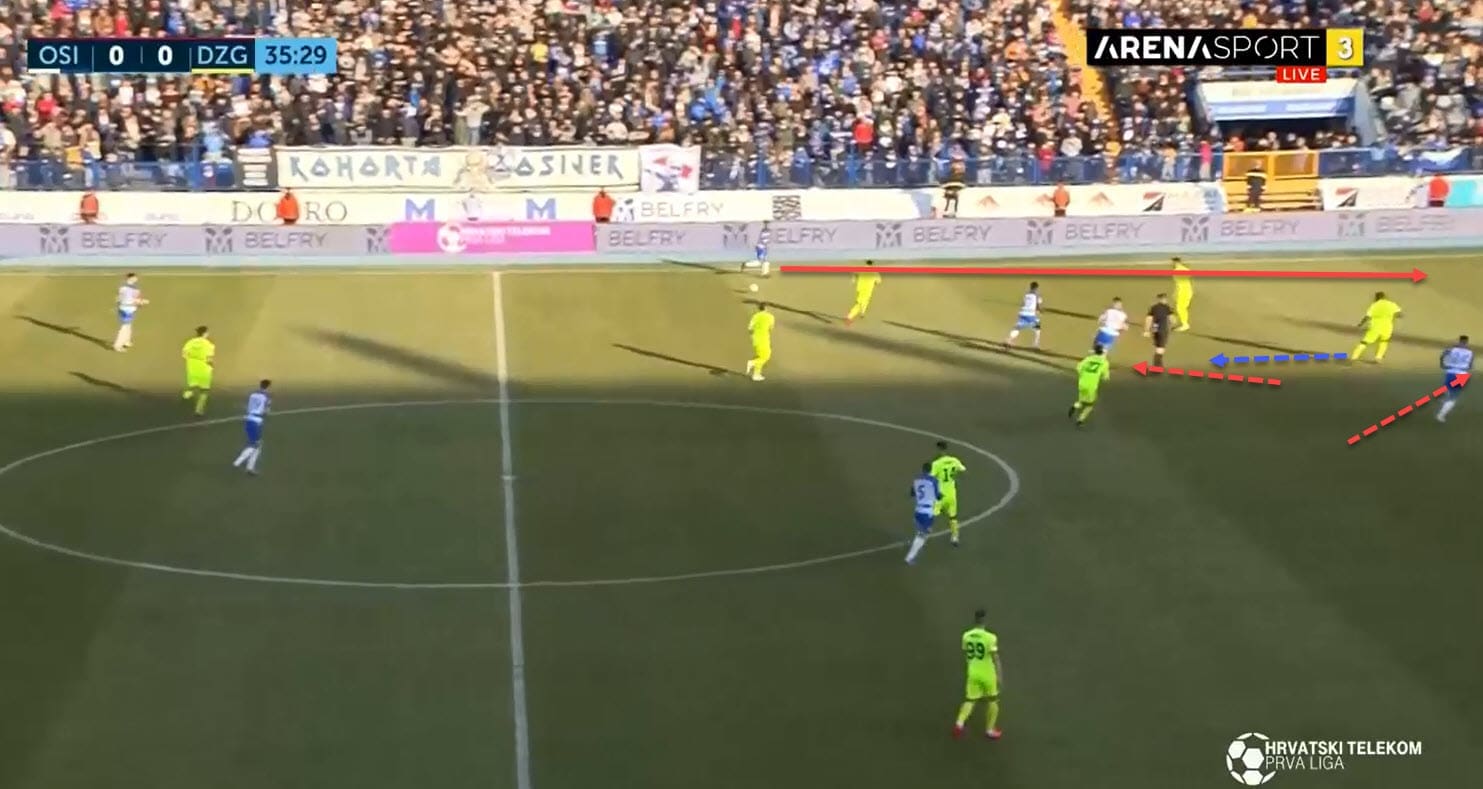
Defensive style of play
We have already established that Osijek are among the highest pressers in the league and even though they don’t keep the opposition as far away from their goal as some of the other top teams, they have a sturdy defence. They have conceded 25 goals in 2019/20 and are one behind Hajduk and Lokomotiva Zagreb, who are tied in second with 24 in that department, while Dinamo are on 11, miles ahead.
But they have also conceded the second-fewest shots per 90 minutes in 1. HNL with 8.98, compared to Dinamo’s 7.63 and the league average of 11.65. So what are some of the main principles behind their effective defensive structure?
We have seen Osijek with multiple systems, depending on the opposition. Mostly, they will deploy a four-man defence and will drop an additional player down to make it five in certain situations. With that in mind, we can talk about a 5-3-2, 4-5-1, or a 4-1-3-2 system and most usually those transform into a 4-4-2 as the ball is progressed forward.
Let’s observe an example against Hajduk below. When they are in a lower block and aiming to absorb pressure, they will often leave just one man in front. We can see the formation shift as soon as the ball is recycled out wide. One player from the middle steps up to press the ball-carrier, the full-back pushes up to press the opposition’s full-back and the midfielder drops deeper to compensate, man-marking his player as well.
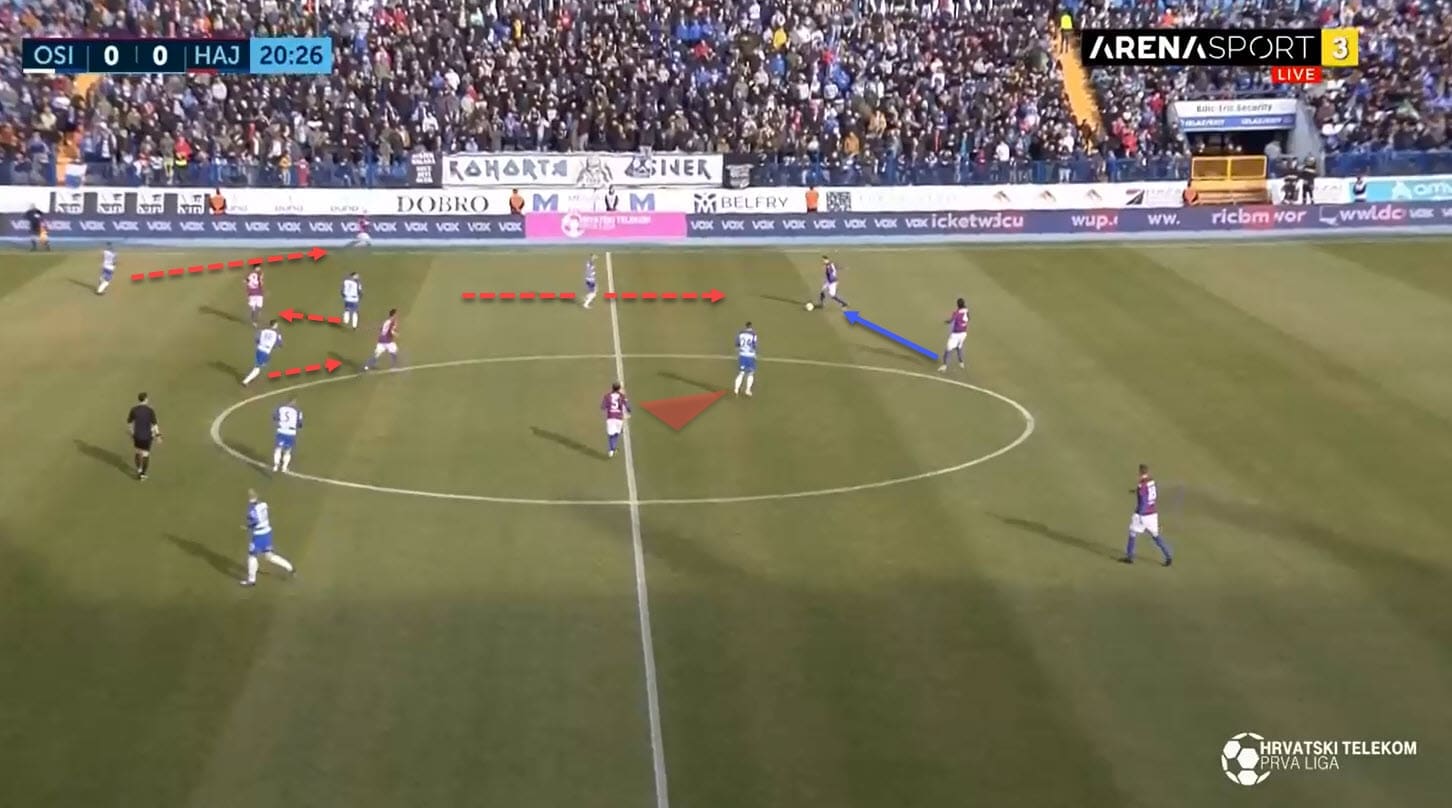
And this is essentially a very common movement we can see them deploy on most occasions when they decide to sit deeper. Their press is activated whenever the ball goes wide, prompting the man from the second line to engage the ball-carrier and usually activates the full-backs as well.
The idea is to either force a mistake near the touchline and break up the attack or, as we’ll see in the following example, direct it towards the middle where they can collapse and snatch the ball away. The image is a graphic representation of a pressing trap they deployed against Dinamo Zagreb.
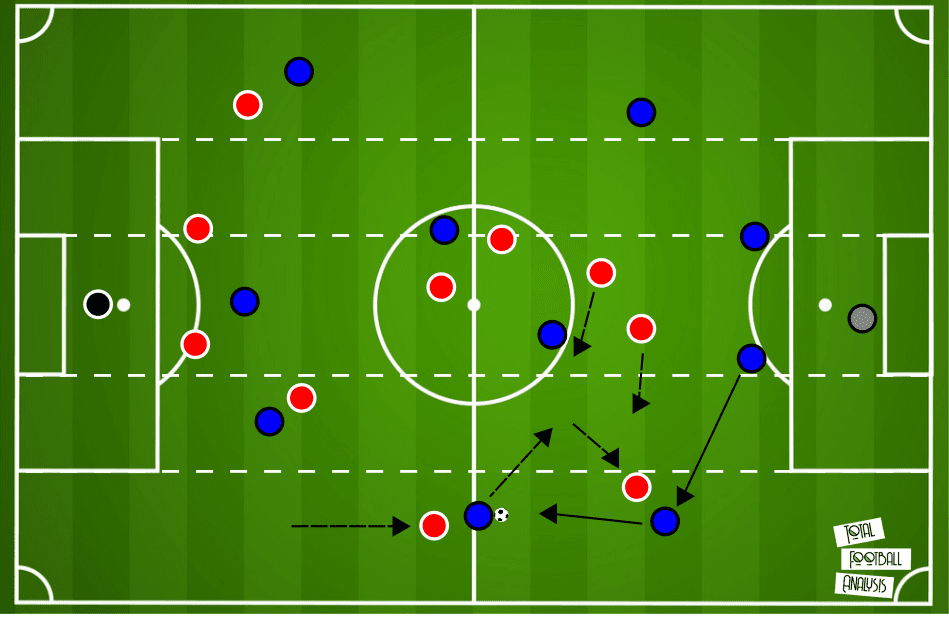
As soon as Dinamo get the ball wide and start to progress it, Osijek’s press is activated. The midfielder engages, the full-back pushes forward and the two other players collapse from the other side, all funnelling towards the middle.
Notice how it forces the opposition’s wide player to cut inside and into the crowded area where he ultimately loses the ball. This system, of course, has some variations in the execution and often, it will be a narrow structure that expands once the pressing triggers are activated.
They also deploy a mix between zonal and man-marking defending, usually staying tight to the opposition’s midfield line and ensuring the middle channels are constantly overloaded. On top of that, we can see a distinct pattern repeat itself whenever they do advance higher to engage – once the full-back steps up, one of the midfielders will take his position in the backline.
We’ve seen that in the example against Hajduk and in the graph against Dinamo. And usually, Kleinheisler is the man to start the switches very often. True to his box-to-box nature, he will drop into the backline when necessary and in case a forward has dropped too deep to receive the ball, he will also push forward and swap places with him. That makes him an incredibly valuable asset in all phases of play.
Not to mention that he can also start the build-up as a pivot picking up the ball from the centre-backs or simply slot next to them in a back three if necessary. But even though Osijek under Kulešević are quite defensively solid when they play in an organised way, it feels like they are more successful when they are on the aggressive.
Despite them sitting in fifth in average recoveries per 90 minutes, only Dinamo Zagreb make more in the final third than Osijek. On top of that, they are third-best in pressing intensity and PPDA values and make the fourth-most fouls per 90 minutes in 1. HNL. This does highlight their aggressive nature and tendencies to force turnovers, which is also evident in 21% of their goals coming from counter-attacks.
Let’s observe an example down below. One of the usual pressing triggers is, of course, the ball being forced backwards and especially if the defender’s body orientation is sub-optimal. We can see in the image that Osijek push in a heavy man-marking scheme and force a long ball towards the frontline from Hajduk.
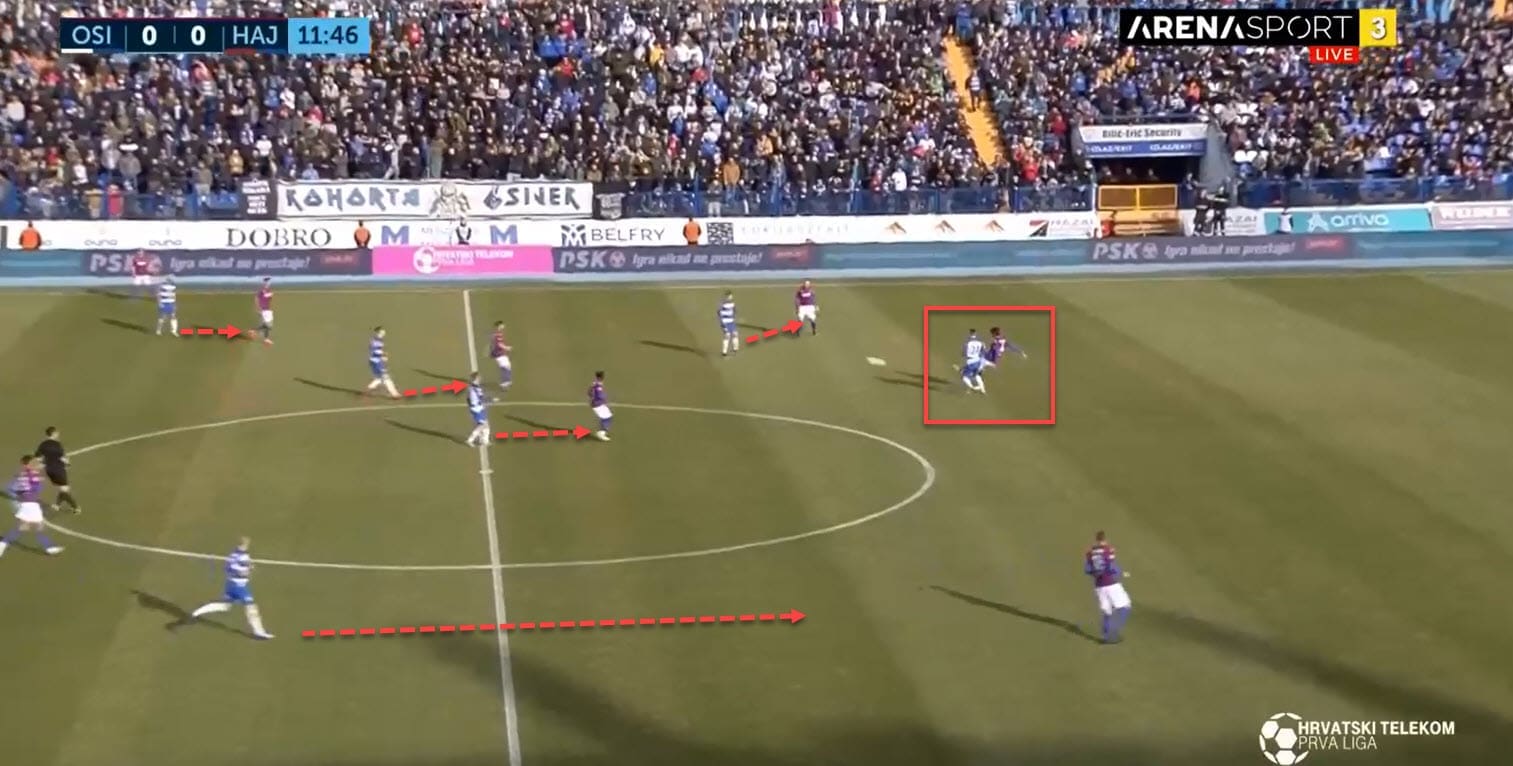
Another thing to note in that concept is that their backline is extremely aggressive as well and they will often break their structure to engage the marker, even if it means pushing slightly forward, as they ultimately do in the action above and are rewarded with a successful transition.
Finally, we’ll quickly observe one example of a successful collapse near the touchline. If Osijek can’t force the opposition into congested central areas, they will look to collapse out on the flanks and squeeze the ball away from the ball-carrier, either by tackling it away, breaking up the attack or just forcing him into a blind or a sub-optimal clearance.
That’s exactly what happened below against Hajduk Split.
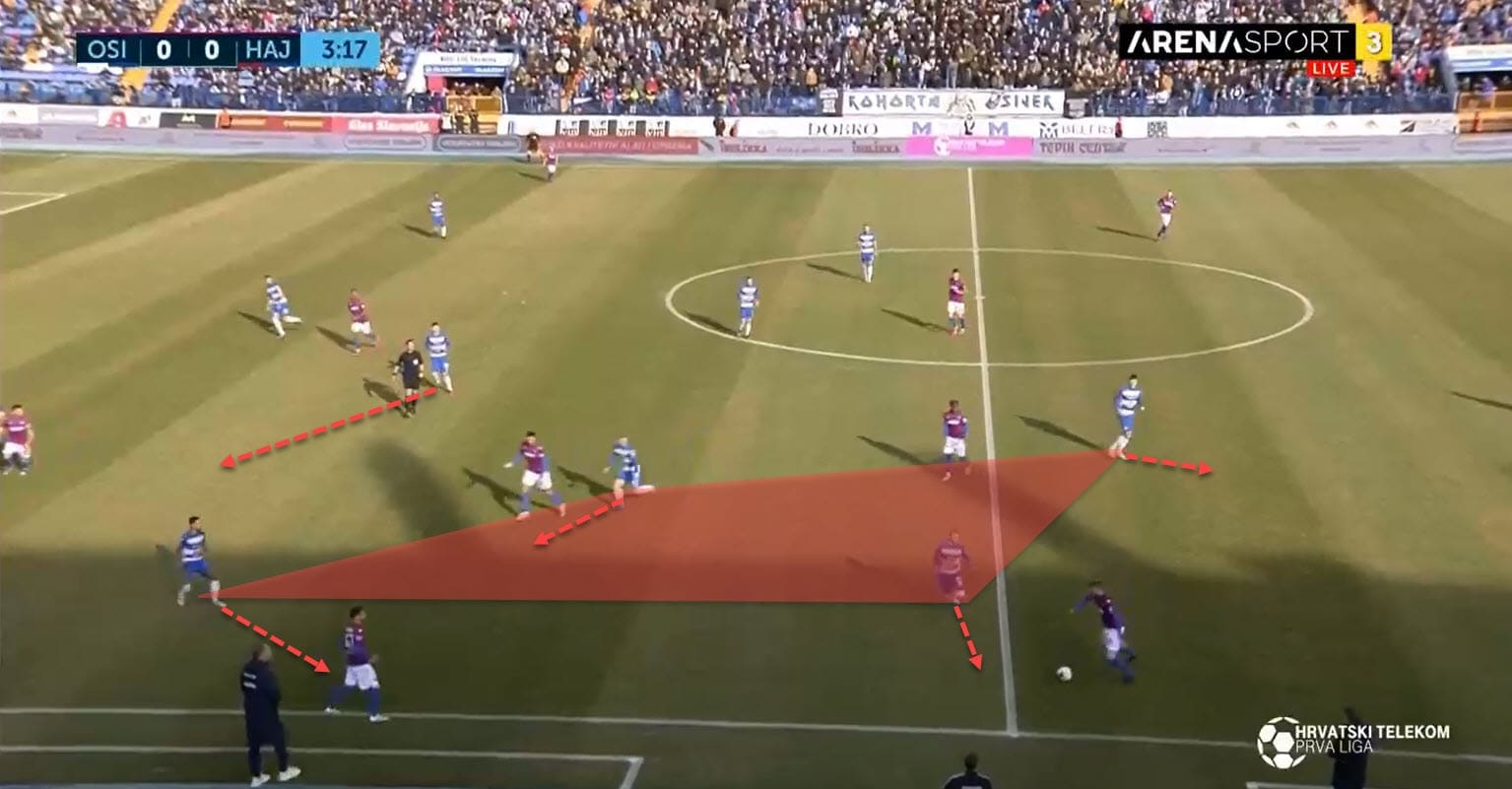
Final remarks
NK Osijek under Ivica Kulešević are currently fifth in the table but they have the resources and the personnel to do much better than that. Individually, they have most of the positions well covered but tactically, they have to improve. The team seems to be torn between styles and sometimes opts to play like a smaller team than they are while they are perfectly capable to do much more.
Kulešević has some great concepts in place at the moment but he will need to decide on his gala XI as well as primary tactics, especially in the build-up phase. Join us next time as our tactical analysis of 1. HNL continues!






Comments